|
|
|
 |
Journalist’s Book “Randi’s Prize” Exposes How ‘Skeptics’ Distort Evidence for Paranormal Activity.
Posted on 21 February 2011, 15:23
As long as works of fiction about girls with dragon tattoos and such things appeal to the masses, it is unlikely that a meaningful book like Randi’s Prize will ever make it to the best-seller list, but in my mind, at least, this book by British journalist Robert McLuhan (below) should be at the very top of the list.
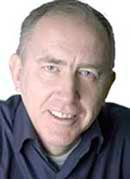
Subtitled “What sceptics say about the paranormal, why they are wrong, and why it matters,” this book deals with things that go to the very core of our existence and which either give meaning to life or, in their absence, suggest that we live in a purely mechanistic universe with no meaning at all. This latter view appears to be that espoused by James “The Amazing” Randi, a Canadian stage magician known mostly as a debunker of paranormal claims. Since the 1960s, Randi has offered a million dollars to any person who can convince him that he or she possesses psychic powers, but the prize remains unclaimed.
An Oxford graduate and member of the Society for Psychical Research, McLuhan, who worked as a foreign correspondent for The Guardian in Spain and Portugal and now works as a freelance journalist, begins the book as a skeptic – an open-minded one – wondering why Randi’s Prize has not yet been won. He examines the evidence advanced by psychical researchers and parapsychologists favoring ESP or psi as well as the survival of consciousness at death and then looks at the counter arguments offered by the “skeptics,” (“Sceptics” in the King’s English). He carefully weighs the evidence for and against and in most cases concludes that the “skeptics” have ignored, twisted, distorted, misinterpreted, disregarded, or otherwise written off the evidence.
I recently interviewed McLuhan by e-mail.
Robert, how did you become interested in this subject?
“I studied literature at university, but then got interested in science, and read books by science writers like Isaac Asimov, Richard Dawkins, Stephen Jay Gould, Paul Davis, that sort of thing. There just happened to be a New Age bookshop near where I worked, and I’d pop in there in spare moments to browse. So I ended up reading a lot of spiritualist-type literature as well. I got interested in such things as mediumistic channeling and near-death experiences. I became aware that science doesn’t accept that there is anything paranormal about them, and that made me curious.”
I gather that you initially found the arguments of the skeptics very persuasive.
“Yes, they had quite a hold on me for a while, they just seemed so authoritative, and their arguments seemed to be based on solid science. But at the same time, what they said didn’t seem to address what people actually say about their experiences, and it was a real struggle to try to work out where the truth lies. It was quite a while before I felt confident about making up my own mind – I didn’t want to feel I was succumbing to wishful thinking, or being superstitious, which is what sceptics always imply.”
So what swung you the other way?
“That started to happen when I realised that sceptics don’t really engage with the parapsychological research at all, but only with the idea that they have of it. They don’t read the literature, so they have only a very vague and general idea of what it is that people report. Not knowing the challenges makes it that much easier to explain it away.”
You obviously have dug deeply into both the old and the new research in both ESP and Survival.
“Yes, I spent a few months reading general books around consciousness and so on, and noticed several references to the Society for Psychical Research. So I decided to check it out, and found that it has a really good little library in central London, packed with useful books, and also its own quarterly publications going back to 1882. It’s a real treasure trove of research on kinds of paranormal topics. I hadn’t realised that so much scientific work has been done into things like ghosts, mediums and telepathy. It was a real eye-opener.”
And yet the skeptics continually insist that there is no evidence. Strange, isn’t it?
“I don’t blame people for feeling sceptical about paranormal claims. In fact I think we should approach the subject with a good deal of caution. But it really makes you wonder about the extent that some scientists are prepared to go to, for instance saying that there is ‘no evidence whatever’ for psychic functioning. That makes no sense to me at all, if you consider all the thousands of reports and studies and investigations that have been carried out over more than a century, and which are published in specialist peer-reviewed journals. There’s an enormous literature. If they wanted to say, there is no ‘scientific’ evidence, that’s something I’d contest, but at least we could have a conversation about it. Or that they aren’t convinced by the evidence, that would be fair enough too. But to say there isn’t any is just silly, and I think rather disqualifies them from being taken seriously.”
So, in a nutshell, what is your take on Randi and his Million Dollar Challenge?
“I actually don’t talk about Randi or the Challenge in the book very much, which I know might seem strange, since I’ve used them for the title. I just thought Randi’s prize was a useful metaphor for a certain kind of sceptical attitude, which is what I was critiquing in general terms. I would have liked to focus on this a bit more, particularly the question why no one has won the prize. This could be for some quite mundane reasons: for instance that the organizers make it really difficult for contestants, in terms of laying down conditions and taking them out of their comfort zone, which from their point of view I suppose is justified. I guess the high profile psychics who might have a chance of winning are already doing well for themselves as TV performers, and they’d have a lot to lose – and nothing much to gain – by risking their reputations. It would make no sense for them, considering how much James Randi himself would have to lose by endorsing anyone as genuine – his reputation, I mean, not the money, which I don’t think is actually his. But it’s still an interesting question.
“In the end, though, I don’t think you can answer it properly without understanding the whole background to the controversy, which is extremely complex. And that’s really what my book is all about.”
To me, the research carried out by pioneers of the SPR, such as Barrett, Myers, Lodge, Hodgson, and Hyslop is very impressive and as solid today as it was then. Yet, it is filed away in dust-covered cabinets. Do you agree?
“Yes I do, and I think it deserves to be better known. The work done with Leonora Piper, for instance – who so interested William James – is a landmark, and helped convince me, for one, that trance mediumship is a genuine phenomenon. Actually I think this could change quite a lot with the Internet. A lot of this material can be found online. The SPR has an excellent online library, where you can get just about any article from their publications within seconds, and hopefully soon it will be making some of the early out-of-copyright material available for free (I’ve published a few tasters on my book’s website http://www.randisprize.net including Richard Hodgson’s Piper papers).
“But it is strange the way the way that historians and biographers have such a distorted view of their work. I’ve recently been reading reviews of a new book by John Gray, a British political philosopher, which debunks people in the late nineteenth and early twentieth century who, he says, chased after dreams of immortality, among them people like Myers and Sidgwick, co-founders of the SPR. Typically, he presents them as odd-balls and eccentrics. No one ever questions why they reasoned the way they did, or relates it to their actual work. They’re just seen as crackpots.”
You discuss the supposed-debunking by C.E.M Hansel, a British psychologists, of the Raymond Lodge group photo. I think this is so typical of the way the skeptics conveniently slant the evidence. (note:Raymond communicated with his father and mother through two mediums after his death and referenced a military unit photo taken just before his death on the battlefield, mentioning that he was sitting with a walking stick across his legs and the officer behind him was leaning on him. At the time, the Lodges had not seen the photo, but it later arrived in the mail. Hansel dismissed the photo as coincidence and made no mention of the officer behind Raymond leaning on him.)
“Yes that’s something that sceptics do a lot, they misrepresent the original details and in so doing make it ripe for debunking. But I singled that instance out, because I think there’s an interesting mental process there. I used to think they did it deliberately, but actually I think that’s often not the case. When they read it, they unconsciously strip out the paranormal element, so that they literally can’t see what the fuss is about. It’s a sort of coping mechanism. Actually I think we all do it, and perhaps that’s a healthy thing – healthy scepticism, if you like. When we read about an allegedly paranormal incident our minds are working to try to provide a normal explanation. But where some of us stay true to the original, others alter it to make a normal explanation easier to identify.”
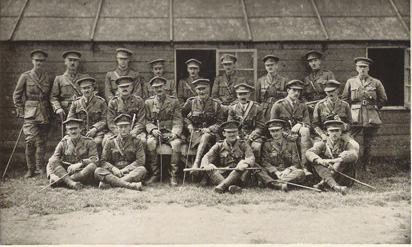
Raymond Lodge - bottom row, 2nd. from the right
And then the skeptics who know nothing of the case read Hansel’s words and accept what he has to say as gospel, although I’m not sure that word is in their vocabulary.
“Yes exactly. That’s what’s so interesting. The literature is full of alleged exposes, confessions and explanations which actually, when you scrutinize them, don’t amount to much at all, and may only have existed in the imaginations of the sceptics who described them. But in some cases, like this one concerning Hansel, you can actually see the process occurring, by comparing the original with the sceptic’s bowdlerized version.”
As you mention in the book, Randi’s attack on the research by Dr. Gary Schwartz is a good example of more modern research in the area of mediumship that has been twisted by the skeptics.
“Actually I do have some reservations about Schwartz’s work, and I think that some of the criticisms made by other sceptics such as Ray Hyman and Richard Wiseman are fair enough. James Randi’s critique of Schwartz really doesn’t amount to much. I don’t get the impression that he’s interested in the details of these studies, if he ever was. He just looses off a tirade of complaints and abuse. He’s really just acting up for his audience. Criticisms are fair enough, when they are cogent and address the issues. But Randi is more in the category of a propagandist. He’s already got his audience. They don’t care about the details either, they just want a champion to voice their own gut feelings.”
You devote a chapter to near-death experiences and frequently mention the debunking arguments of Susan Blackmore. How do you see her arguments and those of other materialistic scientists relative to the NDE?
“Blackmore is certainly one of the more thoughtful sceptics, although I gather she’s rather lost interest in the field now. Her ideas about the near-death experirence, the ‘dying brain’ model, are interesting, and have certainly been very influential. But in order to make it stick she has to be able to explain away the veridical perception reported by patients and accident victims, that they observed what was occurring at the scene – by the roadside or in the operating theatre, or whatever – and that these details corresponded to what they found later occurred. I think this phenomenon has been documented often enough, and with sufficient consistency and corroboration, to be taken seriously. So it’s telling that she has to resort to discrediting their testimony and credibility, even to the extent of impugning their motives. It doesn’t look like science at all, it looks like the bluffing of a courtroom barrister.”
It often seems to me that these so-called skeptics are unable to distinguish religion from general psychic phenomena. Would you agree?
“Up to a point. To be fair, psychic phenomena imply for many people the existence of a spiritual dimension to existence, so religious issues are naturally present. Particularly with regard to afterlife, which sceptics find impossible to believe. But I do think that scientists get onto the subject of religion they go quickly astray. They tend to see it purely in terms of belief, a sort of voluntary identification with the idea that there’s a God and an afterlife, involving faith, and a suspension of reason. They very rarely take account of religious experience, in for instance mystical visions which come unbidden, and which can have life-changing effects, especially in the context of the near-death experience.”
Doesn’t it seem to you like psychical researchers and parapsychologists are forced to continually reinvent the wheel?
“Well, that’s the nature of the game. As long as a substantial section of society disbelieves in what they report then they’ll struggle to even get a hearing. But yes, it’s amazing that the work that has been done is still so little known. As I say in my book, after a century and a half of investigations, if we talk about it all we are still like children asking each other after lights out ‘Do you believe in ghosts?’ The knowledge is there, however, inconclusive, but we have chosen to disregard it.”
Why do you think that is? That to me is the million dollar question.
“That’s perhaps not so strange when you consider how difficult it is to accept. Those of us who have become used to the idea of telepathy, for instance, and have the reading and even the personal experience to back it up, aren’t fazed by it. But it may actually scare some people. Sceptics talk about wishful thinking, but that works both ways: some people are clearly disturbed by the idea of their minds being open for others to read, or of existing for eternity in an sterile and static afterlife. It may also be that we have a natural disposition – some more than others, obviously – to explain it away. It’s the way our minds work, to tell us that what we saw yesterday that we thought was paranormal was actually a trick.
“There’s also the fact that psychic phenomena is so hard to pin down to the satisfaction of science. The claim is extraordinary, but the evidence isn’t extraordinary enough to make it stick. And then of course, if psychic phenomena is held to validate religious belief, that’s difficult in a world in which democracy and secularism are natural bedfellows. No one wants to go back to the old days of warfare between religious factions. Those of us who believe psychic phenomena to be real may not see the danger of that, but I think some sceptics do, and I also think those fears are not necessarily irrational. “
Thank you, Robert. Any final thoughts?
“Yes. I’m very struck by the absence of any serious comment about these things, at least here in Britain. Obviously the paranormal is a huge subject for novels, films and TV dramas, there are loads of books about it being published all the time, lots of websites following it, groups carrying out investigations, and so on. But it’s all on the level of popular culture. Here, it’s vanishingly rare to see anything relating to the paranormal to be discussed in an upmarket newspaper. Intellectuals and opinion-makers agonise about the role of religion in society, but almost always from the narrow faith perspective of the Christian or atheist. For them the paranormal is still unproven at best, or at worst a silly irrelevance.
“I’d like to see that change. That’s why I wrote Randi’s Prize, to try to draw their attention to something that ought to have a huge impact on our thinking, if it was better understood. I particularly want them to see through the myths and generalisations propagated by sceptics and encourage them to look at the scientific research.”
Robert McLuhan can be found at http://www.paranormalia.com and Randi’s Prize is available from Amazon
Michael Tymn is the author of The Afterlife Revealed: What Happens After We Die, Resurrecting Leonora Piper: How Science Discovered the Afterlife and Dead Men Talking: Afterlife Communication from World War I.
Read comments or post one of your own
|
 |
When an “Ape-Man” Materialized in a Scientist’s Lab
Posted on 07 February 2011, 18:36
It is difficult to find anything more bizarre or hokey-looking than various photos having to do with ectoplasm and materialization in books about the paranormal and psychical research. Some of them appear so ridiculous that it is difficult to believe that anyone in his right mind would take them seriously. And yet they were taken seriously by a number of very distinguished scientists, including a Nobel Prize winner in medicine and two British scientists knighted for their scientific work. Moreover, all of those who did take it seriously concluded that it was real. Only the “know-nothings” wrote it off as fraud.
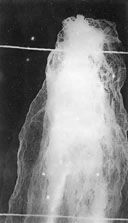
“A materialization in process”
As various researchers came to understand it, “spirit scientists” on the other side of the veil would withdraw “magnetic fluids,” called ectoplasm, from the medium and sometimes from the sitters, and then discarnates would project thought images of themselves, or as they remembered themselves when alive, into the ectoplasm to create materialized likenesses of themselves. They would also sometimes create an artificial voice box so that they could speak. However, only a very small percentage of these materializations were good likenesses of the person when alive. It apparently took some practice or special focus by the spirit entity to carry out a good materialization. One spirit told Dr. Charles Richet, the 1913 Nobel Prize winner in medicine, that he could not materialize because he could not remember what he looked like when alive. Many of the older spirits lived before photography and had no fixed images of what they looked like. Think about it; if you had no photographs of yourself would you remember what you looked like as a child? The ability of spirits to materialize has been likened to asking a person in the flesh to draw a picture of him- or herself. Most people would fail badly at doing a self portrait, but some of the more artistic would no doubt succeed.
Many of the materializations were bizarre to say the least. Some looked like mannequins, some like plastic or rubber dolls, and some were not even three dimensional. They came out as flat drawings. Vice-Admiral W. Usborne Moore, a retired British naval commander turned psychical researcher, reported witnessing two failed materializations. “The figure of a woman tried to build up outside the cabinet, but collapsed before it was completed; and there was one brilliant etherialization outside that fell and dissipated after rising two feet,” he reported. However, Moore’s mother and father succeeded in materializing as did the mother of Dr. Cesare Lombroso, a world-renowned Italian neuropathologist who gave us the science of criminology. The purported mother of Professor C. J. Ducasse of Brown University materialized, but Ducasse said it did not look like her. Dr. John King, a Toronto physician and president of the Canadian Society for Psychical Research, observed a perfect duplicate of his wife, including form, features, voice, and mannerism, together with tangibility, power, and zeal. King reported that she stood and talked with him about personal matters before melting away into the floor.
King also witnessed an actual materialization process. “I noticed a light upon the carpet, phosphorescent in appearance, about the size of a 25-cent piece or English shilling, which soon became more extensive, and apparently rose as a vapor from which evolved curling flame-like white and purple light, until suddenly it took on tangible form, and developed what all the sitters agreed upon as being beyond doubt a beautiful young woman, clad in draperies of creamy white, bearing supported or suspended above her head a purple ball of light, which, however, seemed physically separate from any connection with the head; and which illumined the entire room and simultaneously the air was impregnated with odor of a most delicate and agreeable perfume, resembling nothing I had ever inhaled.”
The spirits who were successful in materializing were limited in how long they could hold on to the earth vibration. It was likened to a human trying to stay underwater.
But not all materializations were spirits of the dead. As reported by Dr. Arthur J. Wills, president of the U.S. College of Psychic Science and Research, a woman named Mary C. Viasek, an experienced astral traveler, conducted an experiment with Mrs. Z. J. Allyn, a materialization medium. While on a train in Utah, Viasek was able to project her etheric or astral body to Allyn’s home in Los Angeles during a séance and to materialize there. She reported encountering a “spirit chemist” who gave her instructions on how to materialize. “Think your features positively, just as you are! Think your hair! Your eyes! Think your form! Think your arms! Think your hands! Think your feet!” Then the chemist placed some substance over her to form her dress, a garment of white lace. This, Viasek explained, was a creation of the chemist, not of her thought. We also get some indication from this as to why some materializations involved only faces or torsos without legs. When one spirit was asked by the sitters why they could see only his face, he responded that he had only visualized his face.
.
But there was also a third kind of materialization – the projection of the medium’s dream world into the ectoplasm. At least this seems to have been the case in some experiments conducted by Dr. Gustave Geley, a French physician and professor medicine, who gave up his practice of medicine in 1919 to become director of the newly organized Institut Metaphsychique International in Paris. He chronicled his experiments in a book titled Clairvoyance and Materialization: A Record of Experiments, which was published after his 1924 death in a plane crash.
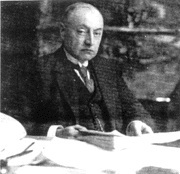
“Gustav Geley”
In a sitting during 1919 with the Polish medium Franek Kluski, Geley reported the materialization of a “strange creature between ape and man.” It was described as having the stature of a man, with a simian face but a high, straight forehead, a large and soft tongue, with facial and body hair, with long arms and very strong hands, and smelling like a wet dog. It would take the hands of the sitters and lick them like a dog. Geley called the creature Pithecanthroupus. It manifested at several séances and at one séance rested its hairy head on the shoulder of one sitter while seizing the hand of another sitter and licking it.
In a sitting on August 30, 1919, Geley reported the “apparition” of apparently the same creature. “It was a creature as large as an adult man, very hairy, with a mane and bushy beard, resembling an animal or very primitive man; did not speak; but made hoarse noises, clicked his tongue, and ground his teeth,” Geley recorded. “When called, he approached, allowed his fur to be stroked, touched the hands of the sitters, and scratched them lightly with claws rather than nails. This was an improvement on previous sittings, when he was violent and rough.”
Four years later, during April 1923 in Geley’s Paris laboratory, Sir Oliver Lodge, the distinguished British physicist and pioneer in electricity, radio, and spark plugs, and his wife, Mary, were among the sitters for an experiment with another Polish medium, Jean Guzik. Due to the sensitivity of ectoplasm to light, darkness was required. (While some mediums, such as Kluski, were strong enough to withstand red light, not all could.) Geley’s protocol involved strip searching Guzik and dressing him in pajamas with no pockets, while sitters on each side of him would hold his hands. The doors were padlocked behind the sitters and sealed with gum paper signed by one of the experimenters. The sitters were then chained to each other and required to hold hands. “Under these conditions, control was absolute, in spite of the darkness, and the control of Guzik, which was extremely simple, gave entire satisfaction,” Geley wrote.
Sir Oliver and Lady Lodge had their second sitting in Geley’s laboratory on April 20. Also present were Professor Richet, Mme. Le Bert, Dr. Lassaliere, Mr. Sudre, and Geley. Sir Oliver recorded his observation that day for Geley: “I am touched on the back as by a fist. Then something passed over my head, slid over my face, and fell on my hands. It was Lady Lodge’s hat, coming from the sofa behind her and to her right. The hands of the medium were held all the time by the little fingers. Lady Lodge is touched as by a tame animal…and with the back of her hand she feels something like the hairy breast of a large dog standing on its hind legs, or a man of small stature. We hear the sound of steps, which were those of a man rather than those of a dog. The ladies thought it might be a large ape or orang-outang. Lady Lodge was the only one to feel it on this occasion. The sensation given by the touch of this fur, which seemed to cover a firm breast, was very peculiar. There was no light despite our wish for it.” Lodge added that Guzik appeared to be sleeping the whole time and they heard a voice from the entity, but no one understood what was said.
Lady Lodge recorded the experience: “We sat, connected by chains as at the former séance, but this time I took off my hat and placed it with my jacket on the sofa to my right, too far for me to reach it, and still farther from the medium, who was on my left. I felt myself stroked on the back as by a stump. This stump, or hand, or paw went to my hair and was entangled in the net which confined my hair. I then felt something pass over my head; it was my hat, carried towards Oliver.”
The red light was then turned on and there was no evidence of the fury creature. After it was turned off, Lady Lodge again felt touches on the back and her hair was ruffled. She lifted her hand in the shackles and touched something hairy behind her. “It was very astonishing to feel that creature behind me,” she added, but she further stated that the creature seemed “good natured.”
Another experiment took place four days later, but Lady Lodge opted not to attend. Geley and Sir Oliver were joined by Count A, de Gramont, Mme. de C., Mr. Ollivier, and Count du Bourg de Bozas. Geley recorded that there were the sounds of footsteps and the displacement of furniture. Three pieces of paper and three pencils were thrown to the floor. Sir Oliver noted that there was enough light to observe the medium next to him and he did not move the entire time. He then felt something touching his arm. “Is it Fango?” Sir Oliver asked. “The creature seemed pleased and touched me twice. I asked if that meant ‘yes’ and was again touched twice. I asked if he knew Raymond, and if the latter were present. (Raymond was Sir Oliver’s son, killed in 1915 on the battlefield). The answer was ‘yes.’ Is it Raymond who touches me? He answered ‘no’ by touching me once.” The entity or creature then whispered in Sir Oliver’s ear and he felt a breath. Sir Oliver thought he heard the creature ask for his name, but it seemed too banal to give it. With his hand shackled to Guzik’s, Sir Oliver reached back and touched a hairy head. “It was round and hard like that of a man whose hair was cut short,” he further recorded.
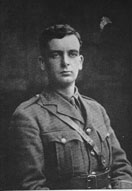
“Raymond Lodge”
Mme de C. also felt the creature touch her on the back and felt a hard head with short hair. Also, she felt a warm breath and her hat was disarranged. When the light was switched on, there was no evidence of the creature, but the displaced furniture was obvious.
Apparently, no one knew quite what to make of it. Lodge concluded that it was phenomena of low order. Between the second and third sittings, Sir Oliver and Lady Lodge sat with another medium and heard from Raymond, who said he was aware of what had happened at that second sitting. “He also told us that the creature we had touched was not an ape, but a primitive man of peaceable character, who answered to the name of Fango,” Sir Oliver wrote. “That was the reason why, when next he appeared, I addressed him by that name.”
Six years later, in 1929, Sir Oliver and Lady Lodge were sitting with Gladys Osborne Leonard, through whom Raymond often communicated over the years. The Paris experience came up and Raymond explained, “Strictly speaking, they had no individual existence as animals, they’re only temporary representation of animals, who have life for the time being.”
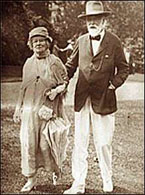
“Oliver and Mary Lodge”
Sir Oliver asked for clarification. “There’s life in them, but that manifestation is temporary, it crumbles and dwindles away,” Raymond responded. “If you were behind the scenes, Father, you would not see a discarnate animal withdrawing himself from the séance conditions and going back to his own spiritual home. You would see something disintegrating and being drawn back gradually, and absorbed again by one or more people on your side.”
Raymond added: “It mightn’t all get into them at once, it could hang about on the fringe of their etheric bodies until it could be absorbed again naturally. That may be very interesting on your side, Father, but we’re not very interested in it from ours. We always wish that the same power of projection which evidently exists in those mediums could be controlled and used by a sensible body of guides so that we could use it and use it intelligently. Instead of which, it’s bound to revert to a low type of elementary physical or animal life, if it controls on your side.”
Raymond went on to explain that it is a kind of phenomenon such as is produced automatically through hypnosis or nightmare or anesthetics.
Then again, perhaps Fango was the spirit of a former pseudoskeptic or debunker stuck in the muck and mire of his own non-belief.
Michael Tymn is the author of The Afterlife Revealed: What Happens After We Die, Resurrecting Leonora Piper: How Science Discovered the Afterlife and Dead Men Talking: Afterlife Communication from World War I.
Read comments or post one of your own
|
|
|
|